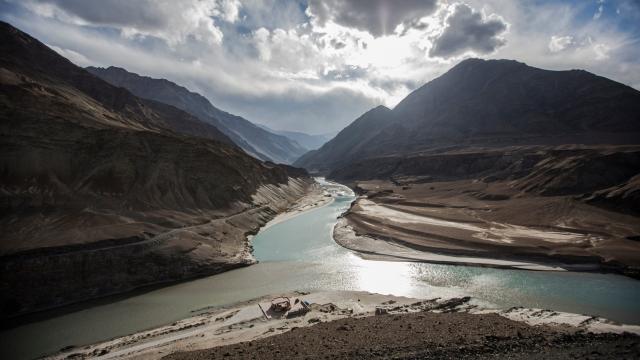Around the world, billions of people rely on water from snow and glaciers. However, rising temperatures and political turmoil could mean rapidly diminishing water resources for these vulnerable regions—most notably being high mountain Asia according to new findings released at the American Geophysical Union.
The study, also published in Nature on Monday, refers to these valuable mountains as “water towers.” While some of us (ahem, me) may imagine tall metal towers with the local town’s name stamped on it, the authors are, in fact, talking about mountains. These are the real water towers of the world.
[referenced url=” thumb=” title=” excerpt=”]
The paper examines 76 mountain regions to explore the climate and societal pressures on water resources. The climate side of the analysis includes temperature and precipitation while the socioeconomic side factors in population growth, economic development, and urbanisation as potential stressors.
Of the 76 regions in the study, the research identifies the Indus Basin tucked between India and Pakistan as both the world’s most important tower and its most vulnerable. More than 200 million people rely on water stored in the high peaks, and that number is set to grow. On top of all that, scientists project the temperature in the region to increase by 1.9 degrees Celsius (3.4 degrees Fahrenheit) by 2050. The two neighbouring countries will have to find a middle ground in managing this water resource if they’re going to succeed in sustaining it, a tall task for two nuclear powers with a history of fighting.
“It’s not only climate change that will influence the water supply of the mountains, but the socioeconomic factors may even be stronger in driving the huge demands ,” Walter Immerzeel, one of the 32 authors of the paper who is also a geosciences professor at Utrecht University in the Netherlands, said during a press conference on the research.
Because of these socioeconomic pressures, mountain regions of South America and Asia rank higher in vulnerability than those in North America. That’s not to say that North American water towers are insulated from threats. Population and temperature increases are putting more pressure on water resources such as the Fraser and Columbia River Basins in the Pacific Northwest.
This is the first index of its kind to measure these competing pressures on the water towers of the world. The findings of increasing stress in many places aren’t necessarily all that surprising because, well, a warmer world is bound to melt some glaciers (which store water) and mess with precipitation patterns. Still, the authors had to devise a particular system to rank water basins. They began by qualifying how important a tower was. They measured this by analysing the precipitation, snow cover, glacier ice storage, and surface water to determine the supply of water it holds. Then, they pit that against the demand. That includes the amount of water needed to meet the demand for irrigation, industry, and domestic purposes. This type of index can be used going forward to plan for future water stress—and potentially mitigating it.
As populations around the world continue to explode, especially in the Global South, leaders will have to shift their conservation strategies to ensure there’s enough water for everyone. And as authors made clear during the press conference on the research, these mountains can also help address the energy crisis we face as we are forced to leave behind fossil fuels through hydropower. Hydropower definitely comes with its own environmental issues, but we do need to reduce greenhouse gas emissions. That’s the first step to protecting the world’s water. And, even then, we’ll still feel the impacts on the global food supply and biodiversity.
“It’s important,” Immerzeel said, “we develop mountain-specific policy to protect and preserve these beautiful mountains.”
